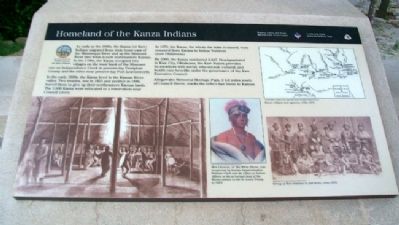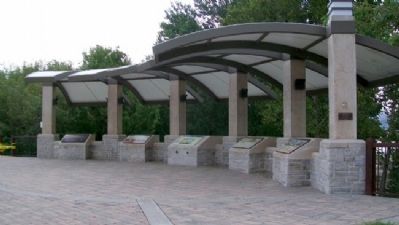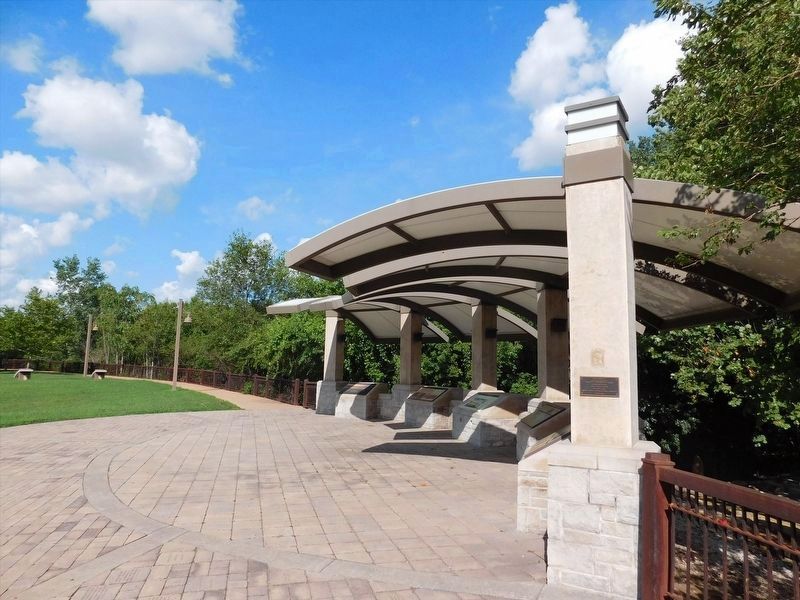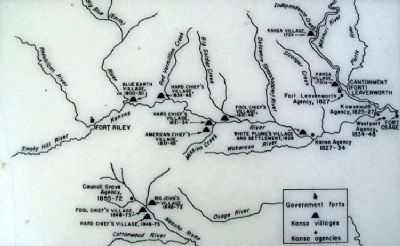Fairfax in Kansas City in Wyandotte County, Kansas — The American Midwest (Upper Plains)
Homeland of the Kanza Indians
As early as the 1600s, the Kanza (or Kaw) Indians migrated from their home east of the Mississippi River and up the Missouri River into what is now northeastern Kansas. In the 1700s, the Kanza occupied two villages on the west bank of the Missouri: one on Independence Creek in present-day Doniphan County and the other near present-day Fort Leavenworth.
In the early 1800s, the Kanza lived in the Kansas River valley. Two treaties, one in 1825 and another in 1846, forced them to give up their northeastern Kansas lands. The 1,600 Kanza were relocated to a reservation near Council Grove.
In 1873, the Kanza, for whom the state is named, were removed from Kansas to Indian Territory (now Oklahoma).
By 2003, the Kanza numbered 2,647. Headquartered in Kaw City, Oklahoma, the Kaw Nation provides its members with social, educational, cultural, and health care benefits under the governance of the Kaw Executive Council.
Allegawaho Memorial Heritage Park, 3 1/2 miles south of Council Grove, marks the tribe's last home in Kansas.
[Kaw Chief painting caption reads] Mon-Chonsia, or The White Plume, was recognized by Indian Superintendent William Clark and the Office of Indian Affairs as the principal chief of the Kanza nation in the St. Louis Treaty of 1825.
[Photo caption reads] Group of Kaw Indians in full dress, circa 1870.
[Background illustration caption reads] "Dog Dance" in a Kanza lodge at Blue Earth Village...
[Map caption reads] Kanza villages and agencies, 1724-1873.
Erected 2004 by National Park Service and Kansas Lewis and Clark Bicentennial Commission.
Topics and series. This historical marker is listed in this topic list: Native Americans. In addition, it is included in the Lewis & Clark Expedition series list. A significant historical year for this entry is 1825.
Location. 39° 6.992′ N, 94° 36.635′ W. Marker is in Kansas City, Kansas, in Wyandotte County. It is in Fairfax. Marker is at the pavilion in Lewis and Clark Historic Park at Kaw Point. Touch for map. Marker is at or near this postal address: 1 Fairfax Trafficway, Kansas City KS 66115, United States of America. Touch for directions.
Other nearby markers. At least 8 other markers are within walking distance of this marker. "the water…contains a half…Glass of ooze" (here, next to this marker); Encampment at Kaw's Mouth - June 26-29, 1804 (here, next to this marker); The Lewis and Clark Expedition (here, next to this marker); "we determin to delay at this Place" (a few steps from this marker); Lewis and Clark at Kaw Point / Kaw Point (within shouting distance of this marker); Bird Woman's Trail (about 300 feet away, measured in a direct line); The Cruise-Scroggs Mansion (approx. half a mile away); Commissioner Thomas F. Lally (approx. half a mile away). Touch for a list and map of all markers in Kansas City.
Also see . . .
1. History of Lewis and Clark at Kaw Point. Friends of Kaw Point Park website entry (Submitted on March 28, 2012, by William Fischer, Jr. of Scranton, Pennsylvania.)
2. Lewis and Clark National Historic Trail. National Park Service entry (Submitted on March 28, 2012, by William Fischer, Jr. of Scranton, Pennsylvania.)
3. The Journals of the Lewis and Clark Expedition. Website homepage (Submitted on March 28, 2012, by William Fischer, Jr. of Scranton, Pennsylvania.)
Credits. This page was last revised on February 10, 2023. It was originally submitted on March 28, 2012, by William Fischer, Jr. of Scranton, Pennsylvania. This page has been viewed 606 times since then and 20 times this year. Photos: 1. submitted on March 28, 2012, by William Fischer, Jr. of Scranton, Pennsylvania. 2. submitted on March 27, 2012, by William Fischer, Jr. of Scranton, Pennsylvania. 3. submitted on April 6, 2022, by Adam Margolis of Mission Viejo, California. 4. submitted on March 28, 2012, by William Fischer, Jr. of Scranton, Pennsylvania.



